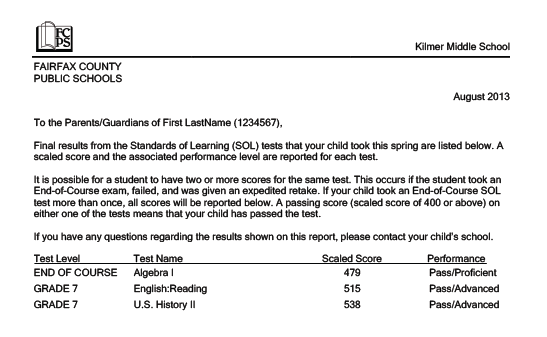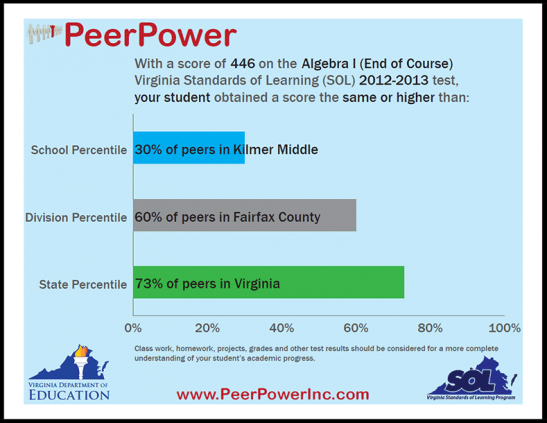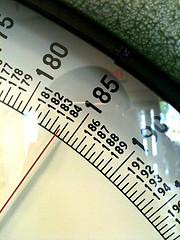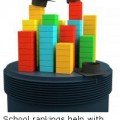Welcome back to school!
By now, kids who took the Standards of Learning (SOL) tests at Fairfax County Public Schools might have received their SOL scores in the mail (or they will receive them soon).
What do these SOL scores mean?
(If you want to understand more about SOL tests, passing rates, and scores, see How SOL passing rates are different from SOL scores)
The letter that parents receive with their kids’ test results via mail look like this:

Sample letter from Fairfax County Schools to parents with SOL Test Scores (courtesy of Peer Power, Inc)
See the “Scaled Score” column on the letter?
That’s the SOL score that the student attained when s/he took the test.
Ok, so that’s a good bit of information but what does it mean?
What does the Scaled Score mean in terms of the student’s performance compared to their peers?
In the sample letter above, looking at the Algebra I test score, is the student behind their peers or did most of the students at their grade achieve “Proficient” on this test?
To find out, you’d have to be able to compare each test score with the rest of them (by class/school, school district, and State).
But that information isn’t on the letter, or on the Fairfax County Public Schools website, or on the Virginia Department of Education website…
So, how can you evaluate the student’s individual score in relation to their peers’?
Ta Da! Enter our good friends at PeerPower,Inc who have created a super useful resource for evaluating SOL scores.
PeerPower helps you evaluate a student’s SOL scores
PeerPower has created a website with data directly from the Virginia Department of Education which allows you to evaluate in which percentile is the Scaled Score for each test.
For example:
- Algebra I with a Scaled Score of 446 at Kilmer Middle School represents a score the same or higher than 30% of peers in Kilmer Middle.
Considering that 50% would be at about the middle of the group of students who took that test, I’d say that this student (at the 30th percentile) could use a little boost in their algebra skills.
As a parent, knowing where my kid is in relation to his peers is important – even if it’s done with a standardized test score. And PeerPower helps parents with this bit of knowledge.
This is what a PeerPower report looks like for each test

Sample PeerPower SOL Score percentile report
Currently, using PeerPower is the only way to access these percentiles, which are more useful to assess how well a student is doing than the raw SOL Score itself.
Other ways how PeerPower percentiles are useful:
- When the tests get harder
- To evaluate if tutoring is helping
- To compare schools
Let’s look at them one by one:
When the tests gets harder
As you may recall, last year, the SOL science tests got harder. And the year before, the SOL math tests got harder.
Almost every student in Virginia saw their scores drop from one year to the next.
However, the score itself won’t say much about how well a student is doing academically. Perhaps a student’s score dropped from one year to the next, but their percentile rank rose among the their peers, which would point to an academic improvement (at least as measured by the standardized tests).
For other students who didn’t see their percentile rank be as high as they’d like, perhaps they engaged in tutoring.
To evaluate if tutoring is helping
If a student is in a tutoring program to improve their academic performance, how could one tell how well the program is helping from one year to the next if the tests are different/harder?
A better way to see if a student is improving is to evaluate their performance on these standardized tests by comparing their scores with their peers’.
But comparing the scores with peers from the same school might not be enough. How about evaluating their performance with the rest of the district, or with another school specifically?
PeerPower’s percentiles are also good for comparing schools
Let’s say that a student is at the top of his class but when compared with the rest of the school district, s/he isn’t doing as well… perhaps that school isn’t challenging enough.
Or if you are planning on moving and want to compare a couple of different schools, you could compare a student’s SOL score with those of the other schools. That evaluation could be a good data point to help you choose the right school.
Would you like to evaluate a student’s SOL scores?
PeerPower is currently offering a 50% off coupon for their upcoming release of 2014 results. Visit them here: http://www.peerpowerinc.com/.
Can you see other ways in which evaluating SOL scores would help?
Please share your thoughts with us in the comments section.







 Everybody is welcome to find a home by school boundary. A school boundary
is simply a geographical area, just like a zip code or a postal city.
Everybody is welcome to find a home by school boundary. A school boundary
is simply a geographical area, just like a zip code or a postal city.
 Does anything on this website bug you? Nothing is too small or too big. If there is something we can fix, we'd love to know.
Does anything on this website bug you? Nothing is too small or too big. If there is something we can fix, we'd love to know.

